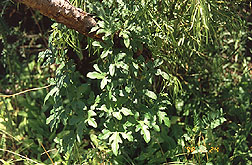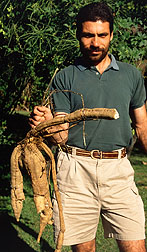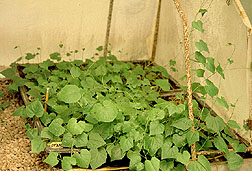TAIUIA—Corn Rootworms Just Can't Get Enough
|
|
South American farmers have a word of advice for their counterparts in the North who are troubled by corn rootworms—and that word is "taiuia." This plant, like squash and cucumbers, is a member of the curcurbit family. But it contains a powerful feeding stimulant that could help farmers control rootworms using less insecticide.
Brazilian farmers have already shared their secret about its powerful root—which looks like an oversized cassava—with Agricultural Research Service scientists. By coincidence, two different farmers told two different ARS scientists about taiuia in the early 1990s.
ARS biologist Willie Cabrera Walsh remembers asking one farmer why he was placing plastic containers with slices of a root that looked somewhat like cassava in his field. The farmer explained they were pieces of taiuia laced with insecticide. The roots lured the corn rootworm adults, and the poison delivered a mortal blow.
Cabrera Walsh works for ARS' South American Biological Control Laboratory in Buenos Aires, Argentina. Many pests that plague North American farmers came from other parts of the world, so having international laboratories to study foreign pests makes sense. Often, natural predators from the homeland can become U.S. control agents.
Entomologist Robert F. Schroder also learned about taiuia from a Brazilian corn grower. Schroder, who is with the ARS Insect Biological Control Laboratory in Beltsville, Maryland, was in Passo Fundo, Brazil, collecting corn rootworm biological controls with entomologist Dirceu Gassen, who is with EMBRAPA, the Brazilian Institute of Agricultural Research.
"We had been using a small, hand-held aspirator to collect the insects. It was a very exhausting process and not very effective," says Schroder. "Gassen introduced me to a man known as farmer Louis, who pulled up this root that had corn rootworms all over it. We didn't know at the time what it was."
|
|
During the rest of the trip, Schroder and Gassen had no trouble collecting samples. They just put slices of the root out where they saw a few of the insects and returned later to collect thousands of them.
Schroder and Cabrera Walsh have been collaborating on their studies of taiuia's potential. Cabrera Walsh sends taiuia samples to Schroder, who assays the extracts and determines their usefulness in controlling corn rootworm adults.
Cabrera Walsh devised a corn rootworm taste test. He put out samples of artificial diets of corn, soybeans, and taiuia. Then, he set loose a group of corn rootworms, allowing them to pick their favorite. What happened next amazed him.
"All the insects crowded around the taiuia," he says. "They wouldn't stop eating, and they wouldn't touch the other samples until the taiuia was gone."
Cabrera Walsh also did a literature search on the plant. He found Brazilian scientist Iniberto Hamerschmidt first reported taiuia's alluring powers in 1985. Hamerschmidt wrote that farmers in Brazil's Curitiba area had been using the plant as a lure since 1979.
Other ARS laboratories are evaluating wild buffalo gourd as a lure, and Schroder had been working with cucurbitacins from mutant watermelons. [See "Corn Rootworms Get Juiced," Agricultural Research, May 1998, p. 11.] But Schroder's lab tests suggest that taiuia is best for luring the southern corn rootworm, one of the many species of this pest complex.
Adult corn rootworms are actually beetles that feed on the corn's silk tassels. The immature larval stage feeds on corn roots. Throughout its life cycle, the pest costs U.S. farmers around a billion dollars each year in crop losses and overhead expense. They've also been known to attack soybeans, squash, melons, and other crops.
About 50 percent of all insecticides applied on row crops in the United States are used against this pest—that's about 20 million pounds a year. And many of the chemicals used to control corn rootworms will soon be banned because of environmental concerns.
Part of the problem with current controls is that it is hard for insecticides to reach the pests, since they lay their eggs in the soil and the larvae feed underground.
But with taiuia as bait, it might be possible to cut the amount of insecticide needed to control the pest. Or farmers might use taiuia to boost the killing power of less effective but environmentally safe pesticides, because taiuia spurs insects to eat more of the toxin.
Why do these pests love taiuia? It's all a part of evolutionary chess. Taiuia, over time, developed higher and higher levels of a number of incredibly bitter compounds called cucurbitacins to keep bugs away. Most plant feeders couldn't stand the taste.
Corn rootworm adults, however, munch away on taiuia. How is that possible? It seems they somehow developed a craving for cucurbitacins, which they store in their own fatty tissues, making them very bitter. This protects the rootworms from predators. In fact, their colorful body markings may be part of this defense.
"Birds are very sensitive to color patterns," explains Cabrera Walsh. "They have to make the mistake of eating a corn rootworm only once. They vomit it up and never eat one again."
Taiuia stores cucurbitacins in its bright-red berries and fat, potato-brown roots that can weigh as much as 25 pounds. Adult beetles feed on the berries, which helps free up the plant's seeds. In that way, the beetle has made an evolutionary bargain with what could have been a bitter enemy.
Since corn rootworms don't shy away from plants that carry cucurbitacins, their once beneficial craving could now become their chief liability. And there's a bonus: Since taiuia repels beneficial insects, they won't be poisoned accidentally when it's used as bait.
|
|
The next question is whether taiuia can be grown in the United States as a crop. It would do best in the southern half of the country, where growing conditions are warmer and generally more like temperate or subtropical South America.
Taiuia berries could be harvested instead of having to kill the plant to harvest the cucurbitacins in its root. Cabrera Walsh says taiuia's agronomic potential would have to be analyzed, perhaps with the help of an industry partner.
And of course, as with any new plant introduction, USDA's Animal and Plant Health Inspection Service would have to certify that taiuia poses no threat to native plant species or wildlife.
Lacking that certification, enterprising South Americans could grow the plant as a crop and ship the cucurbitacin extract in a liquid or powder form to U.S. companies that could then use the material to produce new corn rootworm control products. "With all the good it's doing for South American farmers, it seems a shame taiuia can't also benefit people in the United States and Canada," says Cabrera Walsh. —By Jill Lee, Agricultural Research Service Information Staff.
This research is part of Crop and Commodity Pest Biology, Control, and Quarantine, an ARS National Program that is described on the World Wide Web at http://www.nps.ars.usda.gov/programs/cppvs.htm.
Guillermo Cabrera Walsh is with the USDA-ARS South American Biological Control Laboratory, U.S. Embassy Buenos Aires, Argentina, Unit 4325 APO AA 34034-0001; phone 54 11 4662-0999 or 54 11 4452-4838, fax 54 11 4452-1882 (Dial 104 after the greeting message).
Robert F. Schroder is with the USDA-ARS Insect Biocontrol Laboratory, Bldg. 306, Rm. 322, 10300 Baltimore Ave., Beltsville, MD 20705-2350; phone (301) 504-8369, fax (301) 504-8190.
"TAIUIA—Corn Rootworms Just Can't Get Enough" was published in the April 1999 issue of Agricultural Research magazine.









